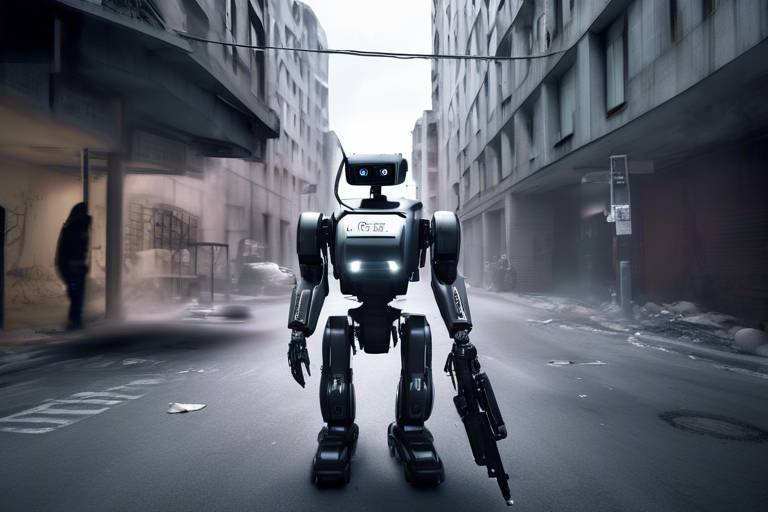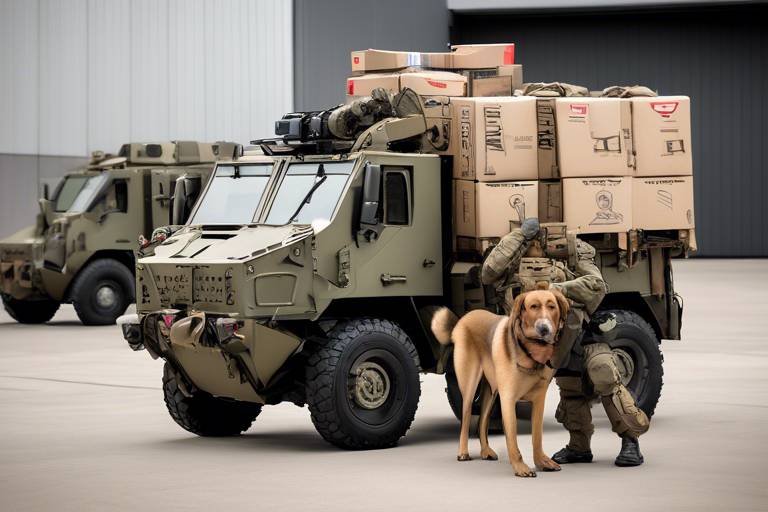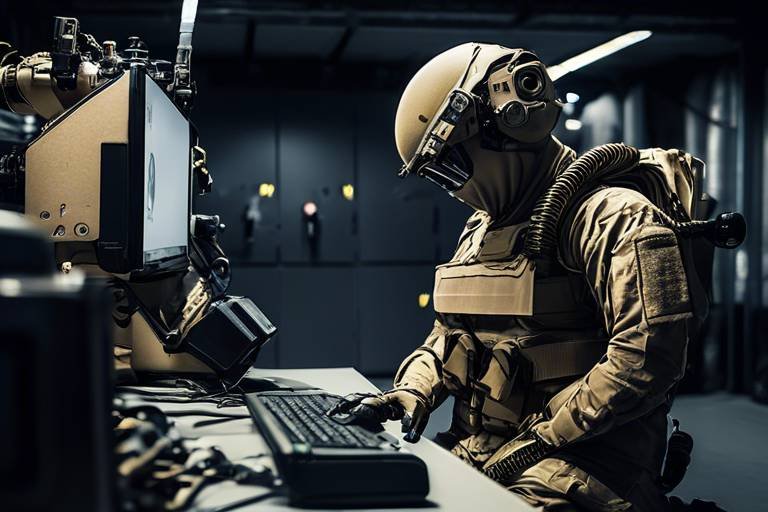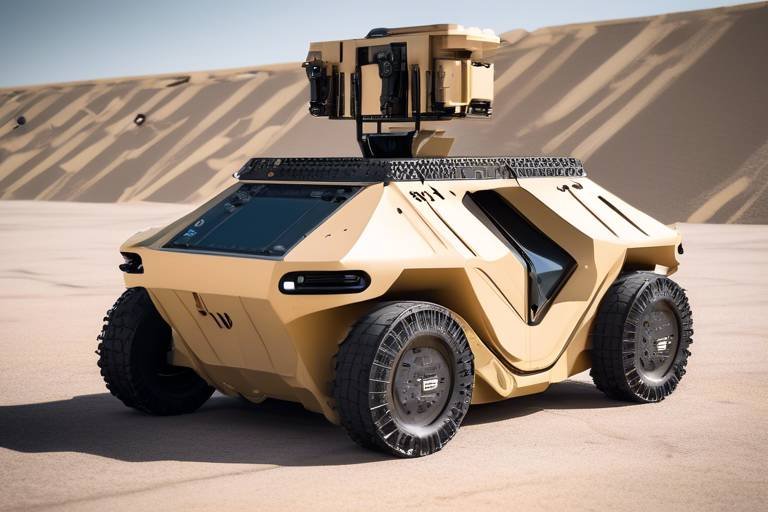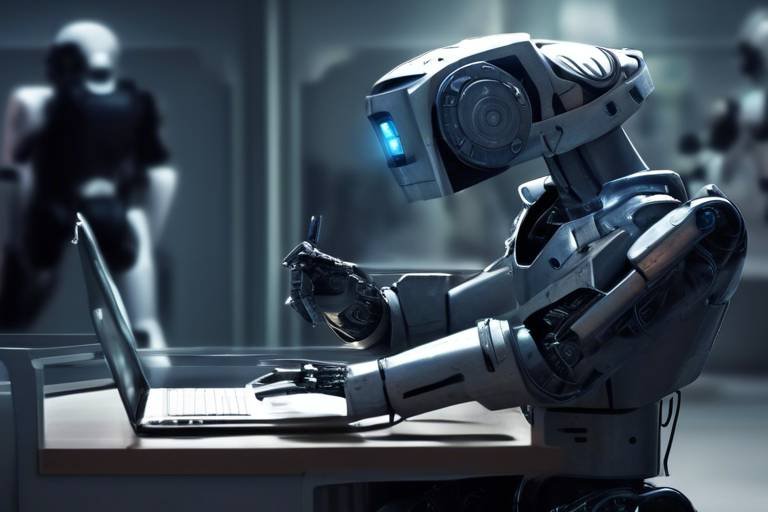The Use of the GHOST Robotics in Urban Operations
This article explores the innovative applications of GHOST Robotics in urban environments, highlighting their impact on efficiency, safety, and the future of city management.
GHOST Robotics represents a breakthrough in robotic technology, designed for versatile urban applications. These robots are not your typical machines; they possess the ability to navigate complex city landscapes with remarkable agility. Imagine a robot that can traverse uneven terrains, climb stairs, and even navigate crowded streets! This versatility makes them ideal for a variety of tasks, from surveillance to emergency response.
Equipped with a unique quadrupedal design, GHOST Robotics can maneuver through tight spaces and adapt to different environments effortlessly. Their robust construction ensures durability, allowing them to operate in various weather conditions, whether it’s rain or shine. This adaptability is crucial for urban operations where conditions can change rapidly.
Public safety is a paramount concern in urban settings, and GHOST Robotics enhances this through advanced surveillance and emergency response capabilities. Imagine having a pair of vigilant eyes monitoring the streets 24/7, ready to alert authorities at the first sign of trouble. These robots assist law enforcement and emergency services, providing real-time data that can be crucial during critical situations.
Equipped with advanced sensors and cameras, GHOST Robotics provides real-time surveillance that can significantly improve monitoring and security in urban areas. Their ability to cover large areas quickly and efficiently means that they can detect unusual activities before they escalate into serious issues. Think of them as the modern-day watchmen, tirelessly patrolling the streets.
These robots can be deployed in various scenarios, from monitoring public events to patrolling neighborhoods. The integration of AI-driven analytics allows them to identify potential threats and notify human operators instantly. This capability not only enhances public safety but also frees up human resources for other critical tasks.
GHOST Robotics can seamlessly integrate with existing smart city technologies. This integration allows for a more cohesive approach to urban management and safety. By connecting with traffic management systems, environmental sensors, and other smart devices, these robots can contribute to a holistic view of city operations.
For example, if a GHOST robot detects a traffic incident, it can communicate with traffic lights to reroute vehicles, reducing congestion and improving emergency response times. This interconnectedness is vital for creating safer and more efficient urban environments.
Real-world examples illustrate the effectiveness of GHOST Robotics in enhancing public safety. In one notable case, a city deployed GHOST robots during a major public event. These robots patrolled the area, providing live feeds to law enforcement and alerting them to any suspicious activities. The result? A significant reduction in incidents compared to previous years.
Another example involved disaster response. After a natural disaster struck a city, GHOST Robotics were deployed to assist in search and rescue operations. Their ability to navigate debris and transmit real-time data to rescue teams proved invaluable, leading to quicker recoveries and saving lives.
In disaster scenarios, GHOST Robotics plays a crucial role in search and rescue operations. These robots can access hard-to-reach areas that may be unsafe for human responders, providing vital information about the situation on the ground. Imagine sending a robot into a collapsed building to assess the damage and locate survivors—it's a game changer!
With their robust sensors and communication capabilities, GHOST Robotics can relay information back to rescue teams, allowing for more informed decision-making and efficient resource allocation. This not only speeds up recovery efforts but also increases the chances of saving lives.
GHOST Robotics is also utilized for environmental monitoring in cities. As urban areas continue to grow, so does the need for effective environmental management. These robots collect data on air quality, noise levels, and other environmental factors, helping city planners make informed decisions.
Advanced sensors enable GHOST Robotics to gather vital environmental data. They can perform tasks such as measuring pollution levels and monitoring wildlife in urban parks. This data is crucial for understanding the impact of urbanization on local ecosystems and can guide efforts to create more sustainable cities.
The data collected by GHOST Robotics can inform urban planning decisions. By providing accurate and timely information, these robots help city planners identify areas that require intervention, such as pollution hotspots or locations in need of green spaces. This information contributes to sustainable city development, ensuring that urban growth does not come at the expense of environmental health.
- What is GHOST Robotics? GHOST Robotics is a company that specializes in developing advanced robotic solutions for urban applications.
- How do GHOST robots enhance public safety? They provide real-time surveillance and can assist law enforcement with data collection and monitoring.
- Can GHOST Robotics operate in bad weather? Yes, they are designed to function in various weather conditions, ensuring continuous operation.
- What kind of data can GHOST Robotics collect? They can gather data on air quality, noise levels, and other environmental factors.
- How do GHOST robots integrate with smart city systems? They can communicate with other smart devices to create a more cohesive urban management strategy.

Introduction to GHOST Robotics
GHOST Robotics represents a breakthrough in robotic technology, designed specifically for versatile urban applications. Imagine a world where robots seamlessly navigate bustling city streets, adapting to the ever-changing environment around them. These cutting-edge machines are not just a figment of science fiction; they are here, ready to transform how we interact with our urban landscapes. With their unique bipedal design and advanced technology, GHOST Robotics is making strides in enhancing urban operations.
What sets GHOST Robotics apart from traditional robotic systems? For starters, their mobility is unparalleled. Unlike wheeled robots that struggle with stairs or uneven terrain, GHOST robots can traverse a variety of surfaces, making them ideal for urban environments where obstacles are the norm. This adaptability allows them to perform tasks in tight spaces, crowded areas, and even in environments that are hazardous to human workers.
These robots are equipped with an array of advanced sensors and cameras, enabling them to perceive their surroundings in real-time. This capability not only enhances their navigation but also allows them to gather vital data, which is crucial for urban management and safety. Whether it's monitoring traffic flow or assessing environmental conditions, GHOST Robotics can provide valuable insights that help cities operate more efficiently.
Furthermore, GHOST Robotics is designed with integration in mind. They can connect with existing smart city technologies, creating a cohesive network of information that enhances decision-making processes. This integration is essential for modern urban management, where data-driven decisions can lead to improved services and a better quality of life for residents.
In summary, GHOST Robotics is not just another technological advancement; it is a revolutionary tool that is set to redefine urban operations. By combining mobility, advanced sensing capabilities, and seamless integration with smart city systems, these robots are paving the way for a future where cities are safer, more efficient, and better equipped to handle the challenges of urban living.
- What are GHOST Robotics? GHOST Robotics are advanced robotic systems designed for versatile applications in urban environments.
- How do GHOST Robotics navigate urban landscapes? They utilize a bipedal design and advanced sensors to adapt to various terrains and obstacles.
- Can GHOST Robotics integrate with smart city technologies? Yes, they are designed to seamlessly connect with existing smart city systems for enhanced urban management.
- What kind of data can GHOST Robotics collect? They can gather a wide range of data, including environmental conditions and traffic patterns.

Applications in Public Safety
The integration of GHOST Robotics into urban environments has revolutionized the way public safety is managed. These advanced robots are not just mechanical entities; they are dynamic tools that enhance the capabilities of law enforcement and emergency services. Imagine a city where surveillance is not limited to static cameras but is instead complemented by agile robots that can navigate through crowded streets and alleys. This is the future that GHOST Robotics is helping to create, making our cities safer and more responsive to emergencies.
One of the most significant contributions of GHOST Robotics in public safety is their ability to perform real-time surveillance. Equipped with cutting-edge sensors and high-definition cameras, these robots can monitor vast areas, providing law enforcement with crucial information that can be acted upon instantly. For instance, they can detect unusual activities, identify potential threats, and even assist in crowd management during large public events. With their ability to cover ground quickly and efficiently, these robots act as the eyes and ears of the police, enabling them to respond to incidents faster than ever before.
Imagine a scenario where a disturbance occurs in a busy urban area. While traditional methods may take precious minutes to deploy, a GHOST Robotics unit can be on-site within seconds, streaming live footage back to command centers. This capability not only enhances situational awareness but also allows for better decision-making during critical moments. The robots can be programmed to follow specific routes or respond to alerts, ensuring that they are always where they are needed most. Their 360-degree cameras and thermal imaging capabilities mean that even in low-light conditions, they can provide invaluable data to first responders.
Another remarkable aspect of GHOST Robotics is their ability to integrate seamlessly with existing smart city systems. This integration allows for a more cohesive approach to urban management and public safety. For example, data collected by these robots can be fed into city-wide databases, helping to identify trends in crime or emergency incidents. This information can then inform resource allocation, ensuring that law enforcement is deployed where they are most needed. The robots can also communicate with other smart devices, such as traffic lights and surveillance cameras, creating a network of interconnected safety measures that enhance overall urban security.
Real-world applications of GHOST Robotics demonstrate their effectiveness in enhancing public safety. For instance, in a recent deployment in a major metropolitan area, GHOST Robotics units were used during a large public festival. They provided continuous surveillance, enabling law enforcement to monitor the crowd for any signs of trouble. Thanks to their rapid response capabilities, potential incidents were addressed before they escalated, ensuring a safe and enjoyable experience for festival-goers. Similarly, in another case, GHOST Robotics assisted in a search and rescue operation after a natural disaster, showcasing their versatility and reliability in critical situations.
Overall, the impact of GHOST Robotics on public safety cannot be overstated. By enhancing surveillance capabilities, integrating with smart systems, and providing real-world solutions to complex urban challenges, these robots are paving the way for a safer, more efficient future. As cities continue to grow and evolve, the role of robotics in public safety will undoubtedly expand, offering innovative solutions to age-old problems.
- What are GHOST Robotics? GHOST Robotics are advanced robotic systems designed for various applications, particularly in urban environments.
- How do GHOST Robotics enhance public safety? They provide real-time surveillance, assist in emergency response, and integrate with smart city systems for better management.
- Can GHOST Robotics operate in adverse weather conditions? Yes, these robots are built to function in various weather conditions, ensuring reliability in all situations.
- What kind of data do GHOST Robotics collect? They gather data related to surveillance, environmental conditions, and urban activities, which can inform city planning and safety measures.

Surveillance Capabilities
In a world where urban environments are bustling with activity, the need for effective surveillance has never been more crucial. GHOST Robotics steps into this arena with a suite of advanced features that redefine how we monitor our cities. Imagine a robot that can navigate crowded streets, all while keeping a watchful eye on potential threats. These robotic entities are not just machines; they are the vigilant guardians of our urban landscapes.
Equipped with cutting-edge sensors and high-definition cameras, GHOST Robotics offers real-time surveillance capabilities that are both impressive and indispensable. The robots can operate in various conditions, day or night, rain or shine, making them incredibly versatile. They can zoom in on specific areas, detect unusual activity, and even recognize faces, providing law enforcement with critical information in real time. This level of surveillance is akin to having a network of eyes across the city, constantly on alert.
One of the standout features of GHOST Robotics is its ability to integrate seamlessly with existing smart city systems. This means that the data collected by these robots can be fed into central monitoring systems, enhancing situational awareness for city officials and law enforcement alike. For instance, if a GHOST robot detects a disturbance in a public space, it can alert nearby officers instantly, allowing for a swift response. The synergy between technology and human resources is a game-changer in urban safety.
Moreover, the robots are designed to operate autonomously, which means they can patrol designated areas without human intervention. This frees up valuable resources for law enforcement agencies, allowing officers to focus on more complex tasks that require human judgment and intuition. Imagine a scenario where a police officer is called to a scene, only to find that the GHOST robot has already gathered crucial evidence and relayed it back to the command center. This not only saves time but also enhances the overall efficiency of public safety operations.
To illustrate the impact of GHOST Robotics in urban surveillance, consider the following table that highlights some of their key capabilities:
| Feature | Description |
|---|---|
| Real-Time Monitoring | Constant surveillance with immediate data transmission to authorities. |
| Facial Recognition | Ability to identify individuals in crowded places, enhancing security. |
| Environmental Adaptability | Operates effectively in various weather conditions and terrains. |
| Autonomous Patrol | Can navigate and patrol designated areas without human control. |
As cities continue to grow and evolve, the challenges of maintaining safety and security will only increase. GHOST Robotics is at the forefront of this evolution, providing innovative solutions that not only enhance surveillance but also foster a sense of security among citizens. With these robots in our urban landscapes, we are not just witnessing a technological advancement; we are experiencing a revolution in how we think about safety in our cities.
- How do GHOST Robotics integrate with existing surveillance systems?
GHOST Robotics can connect with smart city infrastructure, allowing for seamless data sharing and enhanced monitoring capabilities. - What types of sensors do GHOST Robotics use?
They are equipped with high-definition cameras, thermal sensors, and motion detectors to provide comprehensive surveillance. - Can GHOST Robotics operate in adverse weather conditions?
Yes, these robots are designed to function effectively in various weather conditions, ensuring constant surveillance. - How does GHOST Robotics enhance public safety?
By providing real-time data and alerts to law enforcement, they enable quicker responses to incidents, improving overall safety.

Integration with Smart City Systems
In an era where cities are evolving into smart ecosystems, the integration of GHOST Robotics with smart city systems stands out as a game-changer. Imagine a city where robots not only patrol the streets but also communicate with traffic lights, surveillance cameras, and emergency services in real-time. This seamless connection enhances operational efficiency and public safety, making urban environments more responsive to the needs of their residents.
One of the most significant advantages of integrating GHOST Robotics into smart city frameworks is the ability to collect and analyze data from various sources. For instance, these robots can gather information on pedestrian traffic, environmental conditions, and even emergency situations. This data is crucial for city planners and emergency responders, allowing them to make informed decisions quickly. The robots serve as mobile data hubs, relaying critical information back to central systems that manage city operations.
Furthermore, the integration allows for enhanced collaboration among various city departments. For example, when a GHOST robot detects an unusual crowd formation or a potential emergency, it can automatically alert law enforcement and emergency medical services. This rapid communication can significantly reduce response times, potentially saving lives. The robots can also assist in coordinating with traffic management systems to reroute vehicles away from congested areas or accidents, ensuring smoother traffic flow.
Another fascinating aspect of this integration is the potential for predictive analytics. By continuously monitoring urban environments, GHOST Robotics can help identify patterns and trends. For instance, if data shows a spike in foot traffic in a particular area, city officials can proactively deploy resources or adjust public services accordingly. This level of foresight is invaluable in urban management and can lead to improved quality of life for residents.
Moreover, the integration of GHOST Robotics with smart city systems can enhance citizen engagement. Imagine a scenario where residents can interact with these robots via a mobile app, reporting issues like potholes or broken streetlights. The robots can then relay this information back to the appropriate departments, creating a more participatory approach to urban management. This not only empowers citizens but also fosters a sense of community involvement in maintaining their city.
In summary, the integration of GHOST Robotics with smart city systems is not just about adding technology; it’s about creating a holistic urban experience. By facilitating real-time communication, enhancing data collection, and promoting citizen engagement, these robots are paving the way for smarter, safer, and more efficient cities. As urban areas continue to grow, the role of robotics in city management will only become more critical.
- What are GHOST Robotics?
GHOST Robotics are advanced robotic systems designed for various urban applications, including surveillance, public safety, and environmental monitoring. - How do GHOST Robotics enhance public safety?
They provide real-time surveillance and can communicate with emergency services to improve response times during critical situations. - Can GHOST Robotics integrate with existing smart city technologies?
Yes, they can seamlessly connect with smart city systems, enhancing data collection and operational efficiency. - What kind of data can GHOST Robotics collect?
They can gather data on pedestrian traffic, environmental conditions, and emergency situations, which is vital for urban planning and management. - How can citizens interact with GHOST Robotics?
Citizens can report issues via mobile apps linked to the robots, promoting community involvement in urban maintenance.

Case Studies of Successful Deployments
When it comes to the practical applications of GHOST Robotics in urban settings, real-world case studies provide compelling evidence of their effectiveness. One notable example is the deployment of GHOST Robotics in the city of Las Vegas during large-scale events. Here, these robots were utilized to enhance public safety by patrolling crowded areas, equipped with state-of-the-art sensors and cameras. The result? A significant reduction in incidents, as their presence alone acted as a deterrent to potential wrongdoers.
Another successful deployment occurred in New York City, where GHOST Robotics collaborated with local law enforcement to monitor high-traffic areas. The robots provided real-time data, allowing officers to respond swiftly to any emerging situations. This integration not only improved response times but also enhanced the overall safety of the community. The ability of these robots to operate in challenging environments, such as busy streets and crowded public spaces, showcases their versatility and reliability.
In addition to public safety, GHOST Robotics has made strides in disaster response. A striking case study comes from the aftermath of a hurricane in Miami, where these robots were deployed for search and rescue operations. Equipped with thermal imaging and advanced navigation capabilities, they were able to traverse debris-laden areas that were inaccessible to human responders. This not only expedited the search for survivors but also provided critical information to emergency services, enhancing their operational efficiency.
To further illustrate the impact of these deployments, we can look at a table summarizing key case studies:
| Location | Purpose | Outcome |
|---|---|---|
| Las Vegas | Event Security | Reduced incidents and enhanced public safety |
| New York City | Law Enforcement Support | Improved response times and community safety |
| Miami | Disaster Response | Expedited search and rescue operations |
These case studies not only highlight the versatility of GHOST Robotics but also underscore their potential in transforming urban environments. As cities continue to evolve, the integration of such advanced robotic technologies will undoubtedly play a crucial role in shaping the future of urban management and public safety.
- What types of sensors do GHOST Robotics use?
GHOST Robotics are equipped with a variety of sensors, including thermal imaging, cameras, and environmental sensors, enabling them to operate effectively in diverse environments. - How do GHOST Robotics enhance public safety?
These robots provide real-time surveillance, act as a deterrent to crime, and assist law enforcement in monitoring crowded areas. - Can GHOST Robotics be used in disaster scenarios?
Yes, GHOST Robotics are designed to assist in search and rescue operations, navigating through debris and providing critical data to emergency responders.

Disaster Response and Recovery
When disaster strikes, whether it’s a natural calamity like an earthquake or a man-made crisis such as a building collapse, the need for swift and effective response is paramount. This is where GHOST Robotics truly shines, acting as a lifeline in chaotic situations. These advanced robots are not just machines; they are equipped with cutting-edge technology that enables them to navigate through debris, assess damage, and locate survivors in ways that would be perilous for human responders.
One of the standout features of GHOST Robotics is their ability to traverse difficult terrains. Imagine a scene where traditional vehicles are rendered useless due to rubble or flooding. GHOST robots can maneuver through these obstacles with ease, providing critical support to emergency services. They can quickly gather crucial information about the environment, allowing first responders to make informed decisions without putting themselves in harm's way.
In addition to their mobility, these robots come equipped with sophisticated sensors and cameras that facilitate real-time data collection. This capability is invaluable during disaster recovery efforts. For instance, they can detect gas leaks, assess structural integrity, and even identify potential hazards like downed power lines. The data collected can be relayed back to command centers, providing a comprehensive overview of the situation on the ground.
Furthermore, GHOST Robotics can be deployed in search and rescue missions to locate trapped individuals. By utilizing thermal imaging and sound detection technologies, these robots can pinpoint survivors who may be buried under debris. This is not just a theoretical application; there are numerous case studies showcasing successful rescues facilitated by GHOST robots. The quick deployment of these robots can mean the difference between life and death, highlighting their essential role in disaster response.
Moreover, the integration of GHOST Robotics within existing emergency response frameworks enhances their effectiveness. They can be programmed to work alongside human teams, providing real-time support and data analysis. This synergy allows human responders to focus on high-priority tasks while the robots handle hazardous or complex operations. By acting as the eyes and ears on the ground, GHOST Robotics transforms the landscape of disaster management.
In conclusion, the role of GHOST Robotics in disaster response and recovery cannot be overstated. These robots not only augment the capabilities of emergency services but also ensure that the safety of human responders is prioritized. As technology continues to evolve, we can expect GHOST Robotics to play an even more significant role in shaping the future of urban disaster management.
- How do GHOST Robots navigate in disaster zones?
GHOST Robots utilize advanced sensors and AI algorithms to analyze their surroundings, allowing them to navigate through complex terrains and avoid obstacles.
- Can GHOST Robotics operate in extreme weather conditions?
Yes, GHOST Robotics are designed to withstand various weather conditions, making them suitable for deployment in rain, snow, or extreme heat.
- What types of data can these robots collect during a disaster?
They can collect environmental data, assess structural integrity, detect gas leaks, and even use thermal imaging to find survivors.
- How do GHOST Robots communicate with human responders?
They can relay real-time data through secure communication channels, ensuring that human teams have access to the latest information.
- Are GHOST Robotics cost-effective for disaster management?
While the initial investment may be significant, the long-term benefits in terms of lives saved and efficiency gained can outweigh these costs.

Environmental Monitoring
In today’s rapidly urbanizing world, the importance of cannot be overstated. GHOST Robotics stands at the forefront of this critical endeavor, utilizing advanced robotic technology to gather vital data that helps cities manage their ecosystems effectively. Imagine a bustling city where pollution levels are constantly monitored, and environmental data is collected in real-time; this is where GHOST Robotics makes a significant impact. These robots are equipped with a variety of sensors that can detect air quality, temperature, humidity, and even noise levels, providing a comprehensive picture of the urban environment.
One of the standout features of GHOST Robotics is their ability to navigate through complex urban landscapes effortlessly. Whether it’s maneuvering around pedestrians in a park or traversing through narrow alleyways, these robots are designed for versatility. Equipped with cutting-edge technology, they can operate in various weather conditions, ensuring that data collection is consistent and reliable. This capability is crucial as cities face challenges such as climate change, pollution, and urban heat islands, all of which require accurate and timely data for effective management.
Moreover, the data collected by GHOST Robotics is not just numbers on a screen; it translates into actionable insights for city planners and environmentalists. For example, by analyzing air quality data, urban planners can identify pollution hotspots and implement targeted measures to improve air quality. This proactive approach is akin to a doctor diagnosing a patient’s health issues before they become severe. The integration of GHOST Robotics into urban planning processes can lead to more sustainable cities that prioritize the health of their residents and the environment.
To illustrate the capabilities of GHOST Robotics in environmental monitoring, consider the following table that summarizes the key data collection techniques:
| Technique | Description | Benefits |
|---|---|---|
| Air Quality Monitoring | Utilizes sensors to measure pollutants like CO2, NOx, and particulate matter. | Helps identify pollution sources and informs public health initiatives. |
| Temperature and Humidity Tracking | Monitors climate conditions in real-time. | Assists in understanding urban heat islands and weather patterns. |
| Noise Level Assessment | Measures decibel levels in various urban locations. | Informs city planners about noise pollution and its impact on residents. |
As cities evolve, the role of GHOST Robotics in environmental monitoring will only grow. With the ability to provide real-time data, these robots empower urban management to respond swiftly to environmental challenges. This proactive approach is essential for creating resilient cities that can adapt to changing conditions while ensuring the health and safety of their inhabitants.
- How do GHOST Robotics collect environmental data?
They use advanced sensors to monitor air quality, temperature, humidity, and noise levels. - Can GHOST Robotics operate in adverse weather?
Yes, they are designed to function in various weather conditions, ensuring reliable data collection. - What is the significance of real-time data collection?
Real-time data allows city planners to make informed decisions quickly, addressing environmental issues proactively. - How does GHOST Robotics contribute to sustainable urban development?
The data they collect informs urban planning, helping to create healthier, more sustainable cities.

Data Collection Techniques
When it comes to urban environments, the ability to collect data efficiently is crucial for making informed decisions. GHOST Robotics excels in this area, utilizing a variety of advanced sensors and technologies that allow them to gather essential information. Imagine these robots as modern-day detectives, tirelessly roaming the streets to uncover the mysteries of urban life. They employ a range of techniques that ensure data accuracy and reliability, making them indispensable tools for city management.
One of the primary techniques used by GHOST Robotics is remote sensing. This involves the use of sophisticated sensors that can capture data from a distance. These sensors can detect environmental factors such as temperature, humidity, and air quality, providing real-time insights into the urban ecosystem. For instance, if a particular area is experiencing high pollution levels, the robots can relay this information back to city planners, allowing for swift action to be taken.
Another significant technique is visual data collection. GHOST Robotics is equipped with high-resolution cameras that can capture images and videos of their surroundings. This capability is not just about aesthetics; it allows for detailed monitoring of public spaces, infrastructure conditions, and even traffic patterns. The visual data collected can be analyzed to identify trends, potential hazards, or areas that require maintenance. Think of it as having a bird's eye view of the city, where every detail can be scrutinized for better planning and management.
Moreover, GHOST Robotics employs GPS technology to track their movements and the data they collect. This geolocation capability ensures that all information is tagged with precise coordinates, making it easier for urban planners to understand where issues are occurring. For example, if a spike in traffic congestion is detected in a particular area, city officials can quickly pinpoint the location and investigate further. This combination of data collection techniques creates a comprehensive picture of urban dynamics.
To sum up, the data collection techniques used by GHOST Robotics are not just about gathering information; they are about transforming that data into actionable insights. By leveraging remote sensing, visual data collection, and GPS technology, these robots provide invaluable support to city planners and emergency responders alike. The result? A smarter, safer, and more efficient urban environment.
- What types of sensors do GHOST Robotics use?
GHOST Robotics employs a variety of sensors, including environmental sensors for air quality and temperature, as well as high-resolution cameras for visual data collection. - How does GHOST Robotics improve urban planning?
The data collected by GHOST Robotics helps urban planners identify trends and issues in real-time, allowing for informed decision-making and timely interventions. - Can GHOST Robotics operate in disaster scenarios?
Yes, GHOST Robotics is designed to assist in disaster response by providing crucial data and surveillance capabilities in affected areas. - Are GHOST Robotics integrated with smart city systems?
Absolutely! These robots can seamlessly integrate with existing smart city technologies, enhancing urban management and safety.

Impact on Urban Planning
The integration of GHOST Robotics into urban planning is nothing short of revolutionary. Imagine a city where data flows as freely as traffic, where decisions are informed by real-time insights rather than outdated statistics. GHOST Robotics is paving the way for this future, transforming how cities manage resources, respond to challenges, and plan for growth. These robots, equipped with sophisticated sensors and data collection capabilities, provide invaluable information that can significantly enhance urban planning processes.
One of the most compelling aspects of GHOST Robotics is their ability to gather and analyze data related to various urban dynamics. This includes traffic patterns, environmental conditions, and even human activity. By collecting this data, city planners can make more informed decisions that lead to sustainable development. For example, if a GHOST robot detects increased pollution levels in a specific area, planners can prioritize green initiatives or infrastructure improvements in that neighborhood. This proactive approach not only enhances the quality of life for residents but also ensures that urban environments remain livable and resilient.
Moreover, the data collected by GHOST Robotics can be used to model potential urban scenarios. This predictive capability allows planners to visualize the impact of different decisions, such as the introduction of new public transport routes or the development of green spaces. Think of it as having a crystal ball for urban development—city officials can foresee the consequences of their choices and adjust their strategies accordingly. This leads to more effective allocation of resources, reducing waste and maximizing benefits for the community.
In addition to improving decision-making, GHOST Robotics also enhances community engagement in the urban planning process. By providing transparent data and insights, city officials can foster a more collaborative environment where residents feel empowered to voice their concerns and participate in planning discussions. This is particularly important in diverse urban areas where the needs and priorities of different communities may vary widely. When citizens see that their input is valued and that decisions are backed by solid data, it builds trust and encourages greater involvement in local governance.
To illustrate the impact of GHOST Robotics on urban planning, consider the following table that highlights key benefits:
| Benefit | Description |
|---|---|
| Data-Driven Decisions | Utilizes real-time data for informed urban planning. |
| Predictive Modeling | Simulates outcomes of different planning scenarios. |
| Community Engagement | Encourages public participation through transparent data sharing. |
| Sustainability | Promotes environmentally friendly initiatives based on data insights. |
In conclusion, the impact of GHOST Robotics on urban planning is profound and multifaceted. By harnessing the power of technology, cities can evolve into smarter, more responsive environments that prioritize the needs of their residents. As we move forward, it’s clear that GHOST Robotics will play a crucial role in shaping the future of urban landscapes, ensuring that they are not only functional but also sustainable and inclusive.
- How do GHOST Robotics collect data? GHOST Robotics are equipped with advanced sensors and cameras that gather real-time information about urban environments, including traffic patterns and environmental conditions.
- What are the benefits of using GHOST Robotics in urban planning? They provide data-driven insights, enable predictive modeling, enhance community engagement, and promote sustainability.
- Can GHOST Robotics integrate with existing city systems? Yes, they can seamlessly integrate with smart city technologies to improve overall efficiency and effectiveness in urban management.
Frequently Asked Questions
- What are GHOST Robotics?
GHOST Robotics are advanced robotic systems designed to navigate complex urban environments. They utilize cutting-edge technology to perform a variety of tasks, from surveillance to emergency response, making them invaluable in modern city management.
- How do GHOST Robotics enhance public safety?
These robots enhance public safety by providing real-time surveillance and assisting law enforcement and emergency services. Their ability to monitor urban areas continuously helps in crime prevention and quick response to emergencies.
- Can GHOST Robotics integrate with existing smart city technologies?
Absolutely! GHOST Robotics is designed to seamlessly integrate with current smart city systems. This integration allows for improved management of urban resources, enhancing overall city safety and efficiency.
- What role do GHOST Robotics play in disaster response?
In disaster scenarios, GHOST Robotics are crucial for search and rescue operations. They can navigate hazardous environments to locate victims and assess damage, significantly speeding up recovery efforts.
- How do these robots contribute to environmental monitoring?
GHOST Robotics are equipped with advanced sensors that collect vital data on urban ecosystems and pollution levels. This information is essential for managing environmental health and sustainability in cities.
- What data collection techniques do GHOST Robotics use?
These robots utilize various techniques, including real-time sensor data, aerial imaging, and environmental sampling, to gather comprehensive information that aids in urban planning and decision-making.
- How can the data collected by GHOST Robotics impact urban planning?
The data gathered can inform city planners about pollution levels, traffic patterns, and public safety issues. This insight helps in creating more sustainable and efficient urban environments.

